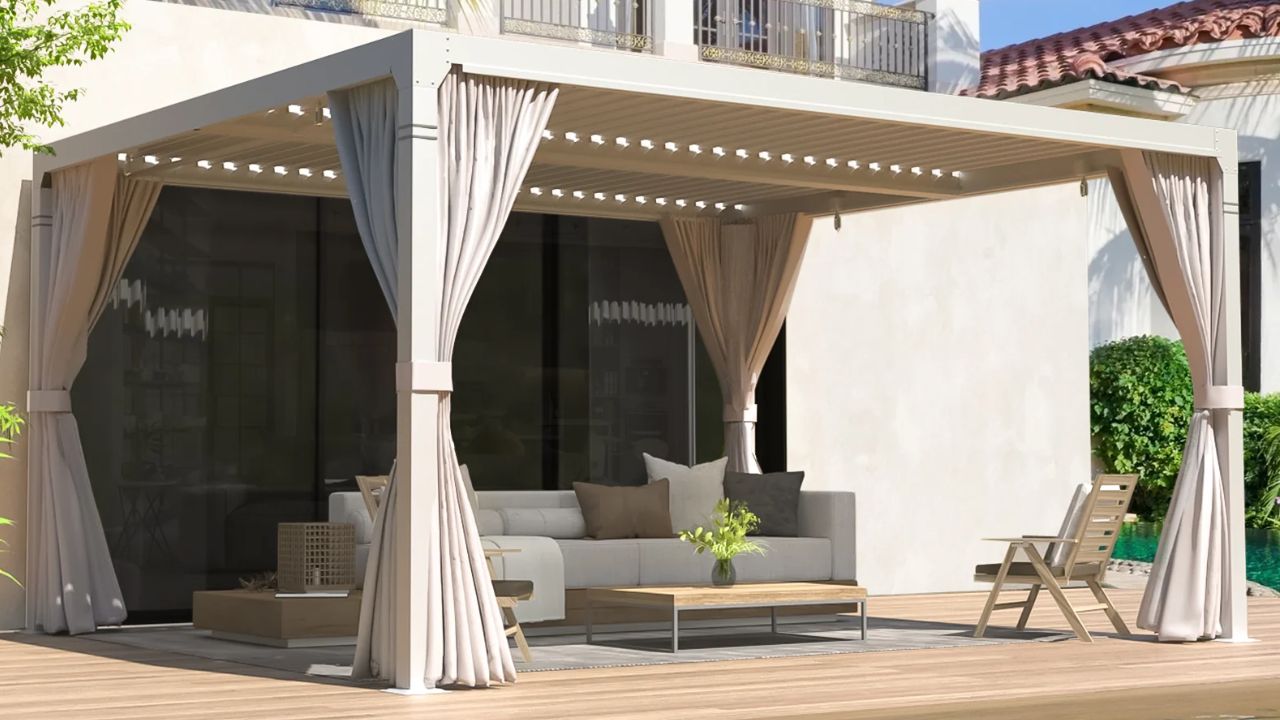Outdoor areas are a growing area of interest for homeowners who want practical and comfortable living spaces.
A patio, garden, or deck area—whatever requires a structure—can be completely transformed into a multipurpose haven. Due to their modern design and practicality, louvered pergolas are increasingly being favored for outdoor home additions.
In the sections ahead, we’ll explore what louvered pergolas are, what makes louvered canopies and pergolas unique, and some of the options you have available. Keep reading.
Understanding All About A Louvered Pergola
What Is A Louvered Pergola?
A louvered pergola is an outdoor structure that enhances functionality and comfort in open spaces. It usually consists of a frame of rectangular or square shape with horizontal louvers. These louvers can be varied to regulate the level of light, shading and ventilation that passes through.
In contrast to conventional pergolas, whose beams are fixed and only partially shaded from the sun, louvered pergolas are, by their nature, flexible. Louvers can tilt or rotate completely, enabling users to adjust to changing weather conditions. This novel design is a great tool for those who want to upgrade their outdoor areas.
Contemporary louvered pergolas are commonly constructed from strong materials such as powder-coated aluminum or steel. These materials can withstand a long period of time and provide weather resistance, making the pergola suitable for a wide range of climates. Their ability to combine functionality and aesthetics lies at the heart of their popularity for patios, decks, and gardens.
How Does It Work?
Adjustable louvers are a characteristic element of a louvered pergola. These slats can be angled in different directions to regulate solar radiation and ventilation. In manual systems, the louvers are controlled by a crank or lever. This option is economical yet requires physical work to use.
In contrast, electric motors are used to position the louvers in motorized systems. The motor operates smoothly, allowing for precise adjustments with the press of a button. Not only is this system easy and convenient but it also improves the overall user experience, particularly for the wide variety of pergolas available.
Overview of Motorization and Automation Features
Motorized louvered pergolas have state-of-the-art functionality, and their structure is extremely efficient and easy to use. Several models are equipped with remote controls, smartphone apps, or wall-mountable switches for simple operation. Some even integrate with smart home systems like Alexa or Google Assistant, enabling voice commands.
State-of-the-art architectures sometimes incorporate weather sensors that automatically control the louvers in response to environmental changes. For example, the louvers can be shut tight in order to form a watertight roof or be turned downwards in response to strong light to give maximum shade. These automation features reduce manual intervention and optimize comfort.
What Are the Different Types of Louvered Pergolas?
Freestanding vs. Attached Pergolas
Freestanding louvered pergolas are freestanding structures that do not use an existing wall or building to rest upon. All of these pergolas can be installed in any area of your outdoor environment, offering creative design and layout freedom. By contrast, attached pergolas are secured to a wall of the house or another building, thus discreetly creating a part of your home.
Freestanding pergolas provide open 360-degree access and suit themselves well to become focal points in large gardens or patios. By contrast, attached pergolas extend the scale one sees indoors, in patios or decks, and are ideal for smaller areas or for those near the house.
Where Each Type Works Best
Freestanding pergolas are ideal for developing independent retreats for example, poolside relaxation settings or shaded garden areas. They are most effective in a big backyard where they can be a focal point or a support to a landscape that already exists.
The attached pergolas are very good in areas where you would like a clear relation between inside and outside. They are frequently placed above patios or decks and offer easy access to shade and shelter. They are also more space-saving, which is suitable for urban and small outdoor spaces.
Durability, Maintenance, and Aesthetics
Regarding low maintenance and modern looks, aluminum pergolas are the best option. Steel has the advantage of being excellent for harsh environments; however, it demands more maintenance. Wood provides timeless charm but needs ongoing maintenance and may not be as versatile for advanced features like motorization. Ultimately, the best material depends on your climate, budget, and design preferences.
Conclusion
A louvered pergola is not simply an outdoor patio; it is a custom fit for shade netting, comfort, and decoration. Its adjustable louvers, tough construction, and adaptable designs offer advantages for different lifestyles and climates.
Knowing the various forms, characteristics, and maintenance needs enables you to choose a pergola that fits your requirements. Whether you care about functionality and aesthetic value or just want an outdoor haven, a louvered pergola is definitely a worthwhile investment.
Take the time to consider your surroundings, your tastes, and your budget, then research the vast array of choices. You’ll find your ideal solution for your home.

